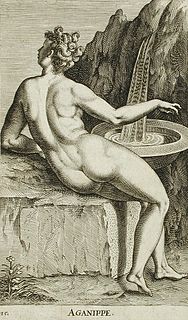
Antaeus, known to the Berbers as Anti, was a figure in Berber and Greek mythology. He was famed for his defeat by Heracles as part of the Labours of Hercules.
The name Cydippe is attributed to four individuals in Greek mythology.
In Greek mythology, Acherusia was a name given by the ancients to several lakes or swamps, which, like the various rivers called Acheron, were at some time believed to be connected with the underworld, until at last the Acherusia came to be considered to be in the lower world itself.
In Greek mythology, the name Toxeus or Toxius refers to the following individuals:
Euryalus refers to the Euryalus fortress, the main citadel of Ancient Syracuse, and to several different characters from Greek mythology and classical literature:
In Greek and Roman mythology, the Astomi, also known as the Gangines, are an ancient legendary race of people who had no need to eat or drink anything at all. They survived by smelling apples and flowers.
Agamede was a name attributed to two separate women in classical Greek mythology and legendary history.
A cunicularium is an establishment of animal husbandry dedicated to the raising of rabbits for meat and fur. This enterprise is known as cuniculture.
In Greek mythology, the name Anthus may refer to:

Staphylus is one of several personages of ancient Greek mythology, almost always associated with grapes or wine:
In Greek mythology, Car or Kar of the Carians, according to Herodotus, was the brother of Lydus and Mysus. He was regarded as the eponymous and ancestral hero of the Carians who would have received their name from the king. He may or may not be the same as Car of Megara
In Greek mythology, Chios may refer to two possible eponyms of the island of Chios:
In Greek mythology, Methe is the spirit and personification of drunkenness. She entered the retinue of Dionysus and was mentioned in association with the god or other companions of his. Methe was the daughter of Dionysus in some accounts.
In Greek mythology, Pandaie or Pandae was a daughter of Heracles whom he fathered in India.
In Greek mythology, the name Hyperbius may refer to:

The Fontes Tamarici, in Spanish Fuentes Tamáricas are three springs located by the geographer and Roman historian Pliny the Elder in classical Cantabria. Since the 18th century they have been identified with the source of La Reana in Velilla del Río Carrión, Palencia, Spain. The first mention of the spring, by Pliny, dates from the time of the Roman conquest of Cantabria. Pliny records that the springs were frequently dry, while other nearby springs continued to flow; he says that the springs being dry was considered to be a bad omen.

In Greek mythology, Aganippe was the name of both a spring and the Naiad associated with it. The spring is in Boeotia, near Thespiae, at the base of Mount Helicon, and was associated with the Muses who were sometimes called Aganippides. Drinking from her well, it was considered to be a source of poetic inspiration. The nymph is called a daughter of the river-god Permessus. Ovid associates Aganippe with Hippocrene.
In Greek mythology, Arabius or Arabus may refer to the following distinct or identical individuals:
In Greek mythology, Philyra or Phillyra was one of the 3,000 Oceanids, water-nymph daughters of the Titans Oceanus and Tethys.
Bratus is the name of a tree Pliny the Elder described in his Naturalis Historia :
Book 12, chapt. 39 —THE TREE CALLED BRATUS.
Hence it is, that they import from the country of the Elymæi the wood of a tree called bratus, which is similar in appearance to a spreading cypress. Its branches are of a whitish colour, and the wood, while burning, emits a pleasant odour; it is highly spoken of by Claudius Cæsar, in his History, for its marvellous properties. He states that the Parthians sprinkle the leaves of it in their drink, that its smell closely resembles that of the cedar, and that the smoke of it is efficacious in counteracting the effects of smoke emitted by other wood. This tree grows in the countries that lie beyond the Pasitigris, in the territory of the city of Sittaca, upon Mount Zagrus.




